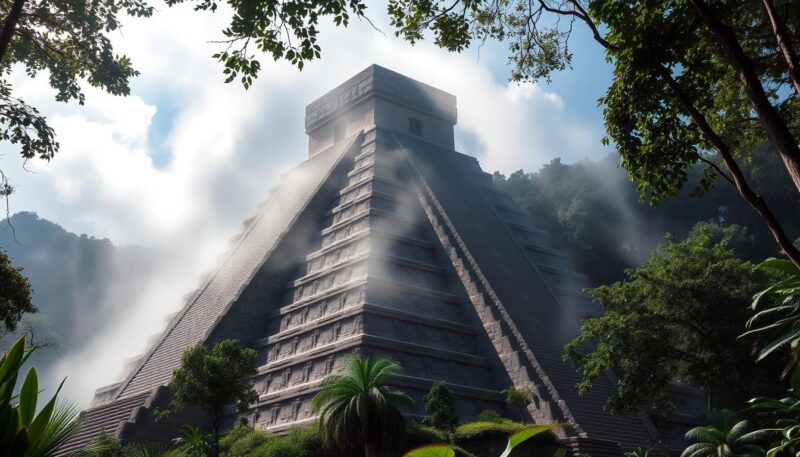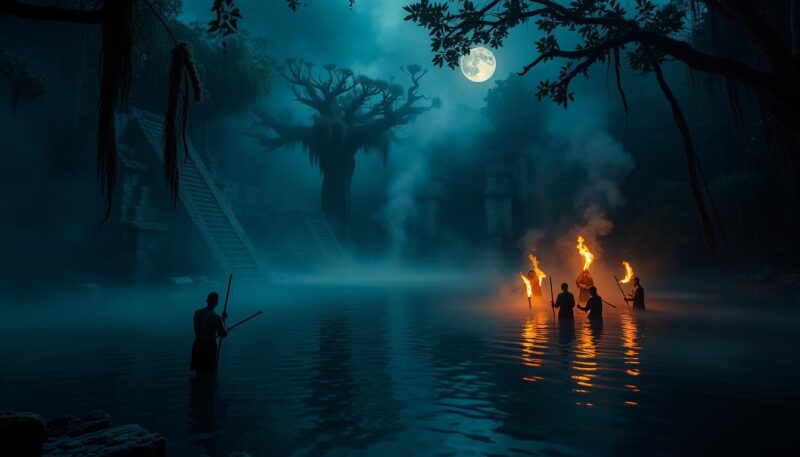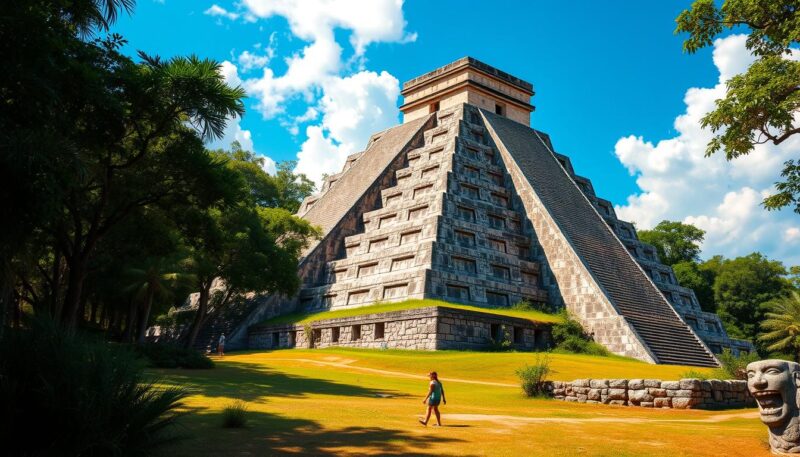Chichen Itza is more than just a remarkable vestige of the Mayan civilization; it stands as one of the most visited archaeological sites in the world, rich with cultural intrigue and historical significance. Established around 550 CE, it reached its zenith in the 9th century, boasting a thriving population of over 50,000 inhabitants. Notably, its strategic position near vital water sources, including the sacred cenotes, fueled this growth. Most will recognize the iconic El Castillo, or the Temple of Kukulkan, which towers to a height of 30 meters (approximately 79 feet) and features an astonishing 365 steps, perfectly mirroring the days of the year.
While its grandeur is simply captivating, Chichen Itza’s story is steeped in surprising Chichen Itza details that often go unnoticed. These include the architecture that reflects both Mayan and Toltec influences after the latter’s invasion in the 10th century. Visitors will discover underground cave systems and advanced astronomical alignments, which further cement Chichen Itza’s status as not just a site of great beauty but also one of immense historical and scientific relevance. In 1988, it was honored as a UNESCO World Heritage Site, and in 2007, it earned recognition as one of the Seven Wonders of the World.
Chichen Itza: A Blend of Cultures
Chichen Itza stands as a testament to the convergence of diverse cultures over time. Originally established by the Itza people in the 5th century AD, the site showcases distinct architectural styles resulting from the interplay between the Mayans and the Toltecs. The observable transitions reveal the complexity of Chichen Itza architecture, influenced heavily by the Toltec invasion in the 10th century. This blend speaks volumes about the cultural and political exchanges prevalent in ancient Mesoamerica.
Not Entirely Mayan
Chichen Itza is not solely a product of Mayan civilization. The architectural elements present at the site illustrate the profound Toltec influence, especially in the Kukulkan Pyramid and the Temple of Warriors. Key features such as the adoration of feathered serpents highlight this integration. This cultural merging contributes to numerous Chichen Itza mysteries, emphasizing its status as a pivotal center where ideas and traditions from different regions coalesced.
The Great Maya Aquifer Project
Recent archaeological finds underscore the significance of the Great Maya Aquifer Project, which plays a crucial role in the sustenance and spiritual practices in Chichen Itza. The extensive network of cenotes, natural sinkholes offering fresh water, directly connects to the agricultural prosperity of the region. Notably, cenote excavations have revealed evidence of Chichen Itza cenote sacrifices, featuring artifacts crafted from precious materials such as gold and jade. These discoveries illuminate the Mayans’ reverence for water, intertwining their physical and spiritual lives.
Interesting Facts About Chichen Itza
Chichen Itza is a site rich in history and wonders, with the Kukulkan Pyramid, or El Castillo, standing out as a remarkable architectural achievement. Beneath its impressive 98-foot structure lie two smaller hidden pyramids, 65 feet and 32 feet tall. These hidden rooms Chichen Itza reflect the pyramid’s evolution over centuries, much like a set of Russian nesting dolls. The Kukulkan pyramid secrets reveal architectural styles from earlier Mayan periods, indicating advanced construction techniques that have intrigued historians for generations.
The Kukulkan Pyramid’s Hidden Structures
The inner pyramids within El Castillo showcase a fascinating aspect of El Castillo history, as they are integral to understanding the site’s architectural significance. Built between 600 and 750 AD, the Kukulkan Pyramid features 365 steps, meticulously designed to represent each day of the year. This clever integration of time and structure exemplifies the Mayans’ remarkable ability to merge functionality with symbolism.
Alignment with Astronomy
A prominent aspect of Mayan culture is their profound understanding of astronomy, which is evident in the design of the Kukulkan Pyramid. The structure is aligned with the equinoxes, marking a spectacular serpent shadow that cascades down its sides during these celestial events, drawing thousands of visitors annually. The observatory, known as El Caracol, served as a vital tool for tracking celestial bodies and contributed to the understanding of Mayan astronomy Chichen Itza. Knowledge of astronomical significance laid the groundwork for many cultural rituals and agricultural practices during this era.

Gruesome Practices and Rituals
Chichen Itza stands as a testament to the complex belief systems and rituals of the Mayan civilization. Among the most startling aspects are the gruesome practices that permeated their society, particularly human sacrifices to the gods. These rituals highlight the weight of social and religious obligations faced by the society and uncover the darker undercurrents of their ceremonial life.
Human Sacrifices to the Gods
The Chichen Itza cenote sacrifices played a crucial role in Mayan religious practices. Ritualistic offerings were made to deities such as Itzamná, the sun god, and Chaac, the rain god, with the hope of ensuring bountiful harvests. Excavations have revealed that many of the bones found in the Sacred Cenote belonged to children aged 3 to 11 years, indicating that the practice might have involved the grim fate of the youngest members of their society.
Analysis of archaeological evidence suggests that all tested individuals from sacrificial contexts were boys, contradicting previous assumptions about the demographics of sacrificial victims. The findings reinforce the notion that sacrifices often directly influenced societal decisions and practices, weaving an intricate web of duty and belief.
Consequences of Competition at the Ball Court
The famed Chichen Itza ball court reveals another layer of the civilization’s harsh realities. This towering structure, the largest in Mesoamerica, hosted high-stakes Mayan ball games that often had deadly consequences. The rules dictated that the losing team faced severe penalties, including potential execution—a reflection of the brutal nature of competition in their culture.
With the court measuring 545 feet in length, its design emphasizes both the physical skill required and the significant cultural implications of these games. Ritualistic carvings found on the relief panels depict the decapitation of team captains, illuminating the gruesome practices associated with these athletic events. Winning was vital, not just for honor, but for survival, marking a severe intersection of sport and spirituality.

| Practice | Description | Significance |
|---|---|---|
| Chichen Itza cenote sacrifices | Ritualistic offerings of children to the water gods | To ensure agricultural prosperity |
| Human sacrifices to the gods | Used primarily male children as sacrificial victims | To appease deities and secure their favor |
| Mayan ball games | Competitive matches with high stakes | Outcome could lead to death, signifying social and ritual importance |
| Consequences of competition | Losing teams faced execution or severe punishment | Reflects the brutal nature of competition in society |
Conclusion
The fascinating journey through the interesting facts about Chichen Itza reveals a masterpiece of Mayan architecture, culture, and history. Established between 600 and 900 AD, this site provides valuable insights into the advancements made by the Mayan civilization, particularly in astronomy, mathematics, and architecture. As one of Mexico’s wonders and a UNESCO World Heritage Site, Chichen Itza attracts millions of visitors annually, eager to experience its unique blend of history and architectural genius.
Beyond its stunning structures, the intricate ceremonies and rituals practiced at this ancient site offer a glimpse into the beliefs that shaped Mayan society. From the human sacrifices that honored the gods to the significance of cenotes as sacred places, Chichen Itza history is rich with narratives that continue to captivate scholars and tourists alike. This cultural heritage ensures that Chichen Itza remains a dynamic symbol of the ingenuity of its creators.
As we reflect on its many layers of influence, it is crucial that preservation efforts continue to maintain the integrity of this remarkable landmark. Responsible tourism is necessary to safeguard Chichen Itza for future generations, allowing them to appreciate its grandeur and the deep-rooted stories interwoven within its walls. Visiting during the better times of day, engaging with its historical context, and respecting the measures put in place are essential steps in ensuring that this jewel of Mexico lasts through the ages.

